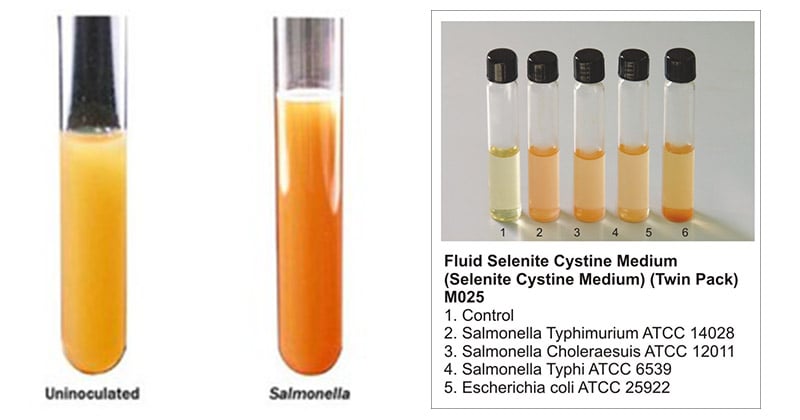Selenite Broth was devised by Leifson, who demonstrated that selenite was inhibitory for coliforms and certain other microbial species, such as fecal streptococci, present in fecal specimens and, thus, was beneficial in the recovery of Salmonella species. Selenite-F Broth is used as an enrichment medium buffered with Lactose Peptone Broth to which Sodium Biselenite is added as the selective agent for the isolation of Salmonella from feces, urine, water, foods, and other materials of sanitary importance.
Interesting Science Videos
Composition of Selenite F Broth
| Ingredients | Grams/liter |
| Casein enzymic hydrolysate | 5.0 |
| Lactose | 4.0 |
| Sodium phosphate | 10.0 |
| Sodium hydrogen selenite | 4.0 |
pH at 25°C 7.1 ± 0.2
Principle of Selenite F Broth
Casein enzymic hydrolysate provides nitrogenous substances, carbon compounds, and vitamin sources. Lactose is a carbohydrate source that maintains the pH of the medium. Selenite is reduced by bacterial growth and alkali is produced. An increase in pH lessens the toxicity of the selenite and results in the overgrowth of other bacteria. The acid produced by bacteria due to lactose fermentation serves to maintain a neutral pH. Sodium phosphate maintains a stable pH and also lessens the toxicity of selenite. Sodium hydrogen selenite (Sodium biselenite) is a very toxic, corrosive agent and causes teratogenicity. Sodium selenite inhibits many species of gram-positive and gram-negative bacteria including enterococci and coliforms. Do not incubate the broth longer than 24 hours as the inhibitory effect of selenite decreases after 6 – 12 hours of incubation.
Preparation of Selenite F Broth
- Add 4.0 gm sodium selenite powder to distilled/deionized water.
- Add remaining 19.0 gm powder to above solution and bring volume to 1.0 liter.
- Gently heat and bring to boiling.
- Dispense into sterile test tubes, at least of a depth of 5 cm.
- Sterilize in boiling water bath or free flowing steam for 10 minutes.
- DO NOT AUTOCLAVE.
- Cool to room temperature prior to use.
Result Interpretation on Selenite F Broth

- After incubation growth of organisms is indicated by turbidity in the medium.
- Cultural characteristics when subculture on MacConkey Agar after an incubation at 35-37°C for 18-24 hours is given as:
- Positive Result: Colorless, Good Growth.
Examples:Salmonella Typhimurium, Shigella sonnei, Salmonella enteritidis, etc. - Negative Result: pink with bile precipitate, Inhibited or no growth.
Examples: Escherichia coli, Enterococcus faecalis, etc.
Uses of Selenite F Broth
- Selenite F Broth is used as a selective enrichment for the cultivation of Salmonella spp.
- It is also used as an enrichment medium for the isolation of some species of Shigella.
- The broth is also recommended for the transport of strains of Vibrio cholerae, because these organisms can survive 2 to 5 days in Sodium Selenite Broth.
Limitations of Selenite F Broth
- Sodium hydrogen selenite (Sodium biselenite) is very toxic, corrosive agent and causes teratogenicity. Handle with great care. If there is contact with skin, wash immediately with lot of water.
- Enrichment broths should not be used as the sole isolation medium. They are to be used in conjunction with selective and non-selective plating media to increase the probability of isolating pathogens, especially when they may be present in small numbers.
- Due to nutritional variation, some strains may be encountered that grow poorly or fail to grow on this medium.
References
- Atlas R.M and Snyder J.W. 2014. Handbook of Media for Clinical and Public Health Microbiology. CRC Press. Taylor & Francis Group. 6000 Broken Sound Parkway NW, Suite 300 Boca Raton, FL 33487-2742.
- E&O Laboratories Ltd- Selenite F Broth (BM0360).
- Sisco Research Laboratories Pvt. Ltd.- Selenite F Broth
- HiMedia Laboratories Pvt. Ltd.- Selenite Broth (Twin Pack) (M052).
- Becton, Dickinson and Company, BBL
- Acumedia Manufacturers, Inc.- SELENITE BROTH (7155).
- Conda Lab- Sodium Selenite Broth (1222).

Useful information